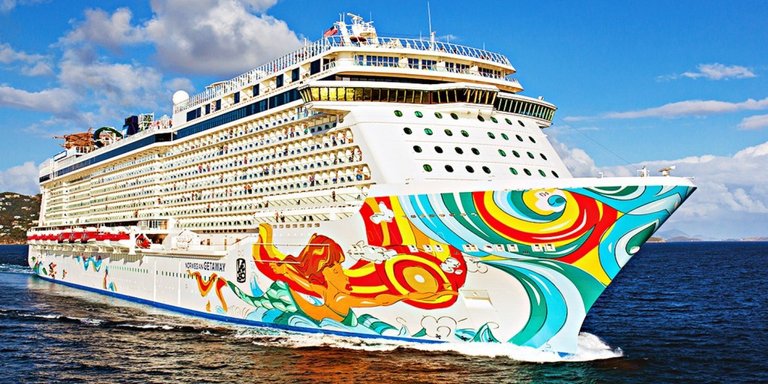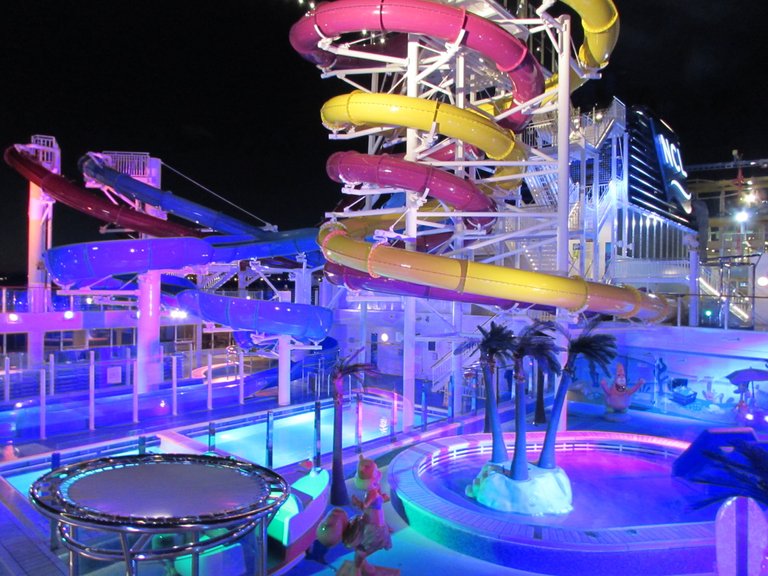
The Aqua Park on board Norwegian Getaway
‘It’s not so bad,” someone said. “You’ll be really pleased you did it,” added another. I craned my neck to look up at the green capsule, and the human silhouette within it. The shadow hovered for a moment before the floor beneath gave way and it disappeared down a long and decidedly vertical tube.
On the upper deck of Norwegian Getaway, conversation revolved around this particular waterslide, known as Freefall: “I screamed as if I was being murdered”… “If you like rollercoasters you’ll be OK”… “You actually go upside down”.
One day, I passed a teenager and his aunt pledging to tackle Freefall together. “If we go up there, there’s no backing out,” she warned him. I saw them again later. He’d backed out. You can tell a lot about a cruise ship from its top deck, and in Norwegian’s case – the livery of its hulls, which are commissioned to artists. For Getaway, Miami’s David “Lebo” Le Batard created a whimsical mural featuring a mermaid, palm trees and pelicans, a tropical theme that permeates other spaces on board.
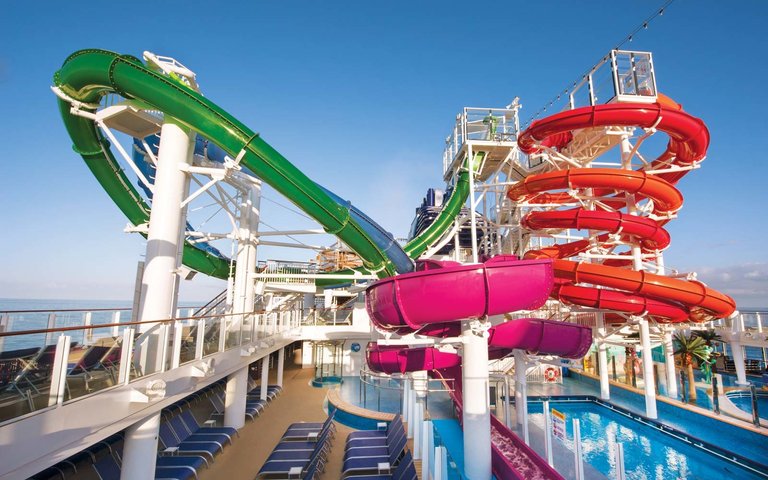
Norwegian Getaway sports five water slides of differing speed, incline and garish colour
While the Queen Mary 2, that matronly aunt of ocean liners, offers decorous pursuits such as golf and shuttleboard and kennels for passengers’ pooches, Getaway sports five water slides of differing speed, incline and garish colour, as well as a rock climbing wall. The piece de resistance, however, is the ropes course, where braver souls than I wobbled their way across beams, ladders and tightropes suspended 180ft above the Caribbean Sea.
And when I say braver souls, I mean almost everyone: young teenagers, aunties, grandpas. If there’s one unifying factor on this ship, it’s that the passengers are pretty game.
Halfway through our seven-day sailing from Miami – stopping at resort-style islands off the coast of Honduras, Belize and Mexico – I realised that the thermal hooded capes hanging on a rail near the grand staircase were not emergency wear for the crew. They were required outerwear for the SVEDKA/Inniskillin Ice Bar, where, for $20, you could imbibe neon vodka drinks in a small dim room kept at a permanent zero degrees Celsius. Why anyone who had chosen a Caribbean cruise should opt for voluntary hypothermia was baffling, but I saw one couple stick it out for more than half an hour.
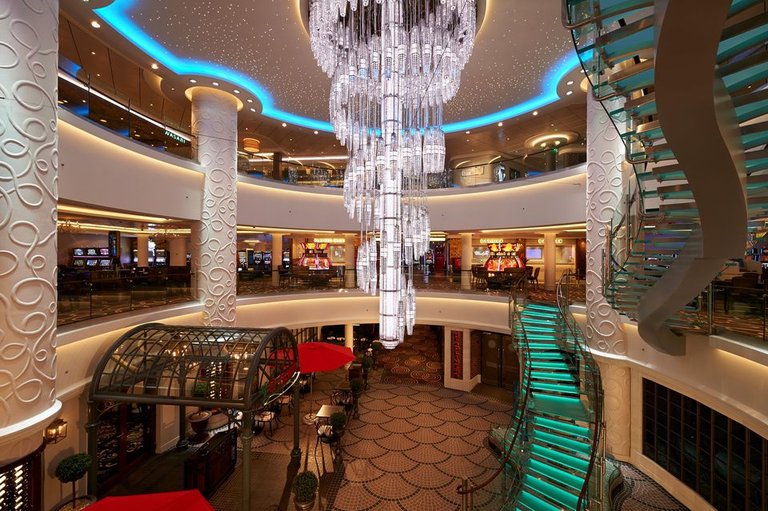
The ship's vibrantly colourful atrium
NCL was the first cruise ship to shake off formal dining and, late last year, the first to include gratuities and premium drinks in the fare for British travellers. Kathy and Jenny, a mother and daughter from North Dakota, told me they always travel with Norwegian now. “A lot of other lines are fancier,” said Kathy, “but we don’t want to have to sit down to dinner at a particular time, and it’s pretty good value too.”
The entertainment certainly is: West End-grade shows such as Burn the Floor and Million Dollar Quartet, and a steampunk dinner theatre called the Illusionarium that could win an Olivier Award for set design. But sometimes the ship’s message of limitless indulgence (NCL’s mantra is “feel free”) clashes with the occasional note of penny-pinching. You can order king crab but the coffee was, in my opinion, uniformly terrible unless you paid for a Lavazza cappuccino (served complementary at mealtimes) – and then it was only mildly disappointing.
I travelled just before the introduction of premium all-inclusive fares for the British market, so if you really wanted to “feel free”, you had to buy the unlimited beverage package at a whopping $79 per day (plus 18 per cent gratuity). Still, everyone I met seemed to do so – even a pair of Jehovah’s Witnesses who only drank a couple of glasses of wine a day.
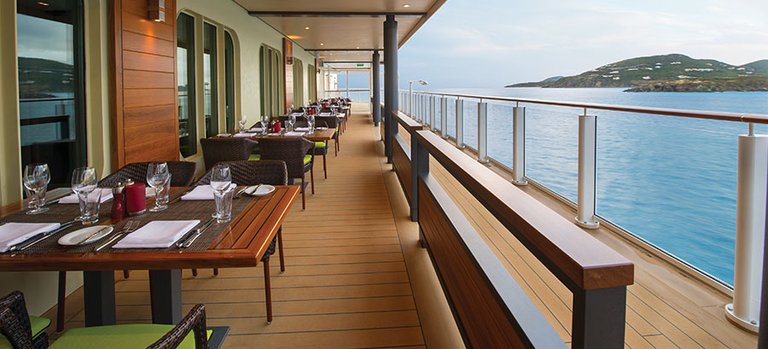
NCL was the first cruise ship to shake off formal dining
After a day at sea, we arrived at Roatan Bay, a Honduran island only four miles wide, whose port is purpose-built for cruise ships. Comprehensively one-upping it was Harvest Caye, which we reached 24 hours later. The entire island was purpose-built for cruise ships. A couple of years ago there was nothing here but mud: it opened in November 2016 a beach idyll, with loungers for every one of the 2,000 passengers who descended on it, a lagoon for kayaking and a pool with a restaurant and swim-up bar.
The staff all commute from mainland Belize (while the island is owned by the cruise line, the businesses on it are locally owned and run), and were incredibly good natured, especially as they dealt with the onrush of kids and adults keen to try out their zip lines (apparently the 136ft imitation lighthouse from which they descend is Belize’s second tallest structure). Floating on the sea you’d look up to see one of these harnessed heroes at full stretch, crossing the sky like Superman. Perhaps Superman didn’t wave quite so much.After a tranquil afternoon on shore, it took a little time to reattune to the barrage of sounds around the central decks, particularly the atrium, where there always seemed to be some sort of audience gameshow going on. (I’d thought nothing could beat the crowd they drew for Deal or No Deal – then they staged Celebrity Dance-Off, complete with a judging panel made up from the ship’s crew, and it was like Waterloo on a train strike day.) Even the incredibly well appointed spa – whose salt room, steam room and multiple saunas positively gleamed with health – had a way of amplifying noise so that the hydrotherapy pool sounded like Niagara Falls.
The staterooms themselves are a comparative oasis: plenty of space and storage, nice décor, football on the telly and a decent rolling movie channel that only seemed to offer Matthew McConaughey on a loop because Interstellar’s so interminably long. There are more free movies cunningly hidden among the pay-per-view list if you go digging. The towel animals are a delight; the shower gel is the kind of thing you’d pump out in a swimming pool changing room.
It’s that funny mix of high and low-end again, nowhere more apparent than in the restaurant offering. The all-day buffet, at the Garden Café, is very good, and I’d have happily worked my way around its manifold stations all week. Other free dining options are a noodle bar, an ersatz Irish pub, and three a la carte-style evening restaurants. There are close to 30 restaurants on board, including a steakhouse, a sushi bar, and a fine dining seafood restaurant, that require you to pay considerable supplements to eat there. Many of the passengers I met avoided them because of the cost. You don’t need to fork out extra at the Cagney’s Steakhouse when you can get a decent filet mignon anywhere on the ship.

Roatan Bay, a Honduran island only four miles wide
Still, I would recommend the Teppenyaki restaurant ($25pp extra) where the shrimp and scallops are the size of a toddler’s fist. Our self proclaimed “fake Japanese chef” Alfred cooked them in front of us, entertaining us with his patter and his tricks with eggs. When we’d arrived, I’d heard rowdy singing in the next room, and assumed it was a particularly inebriated group of friends. I was wrong: within half an hour, we too were thumping our fists on the table in a chorus of Gangnam Style.
Amazing how the spirit of the Getaway can infect you. On our final shore day, at Cozumel, I had joined an excursion offering the mid-octane thrills of quad biking through the Mexican jungle: halfway round, our guide showed us a pool where the Mayans had sacrificed virgins to their rain god. It was a 30ft drop, but the water was deep, he assured us and perfectly safe. Whether it was his reassurance, or the bandanna I was wearing, or the fact that I chickened out of the waterslide, I decided I wasn’t going to miss my moment again. With the encouragement of a dozen Getaway-ers, I tombstoned into that ancient spot of carnage – and I loved it. And no. I still haven’t been on Freefall.
It,s beautyfull
My favorite one.
